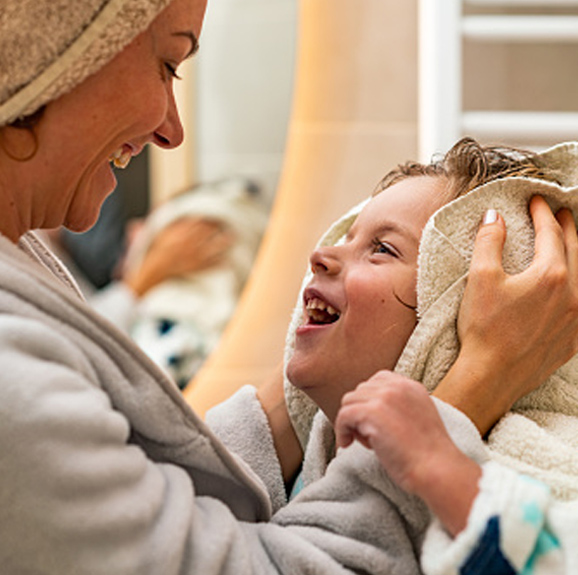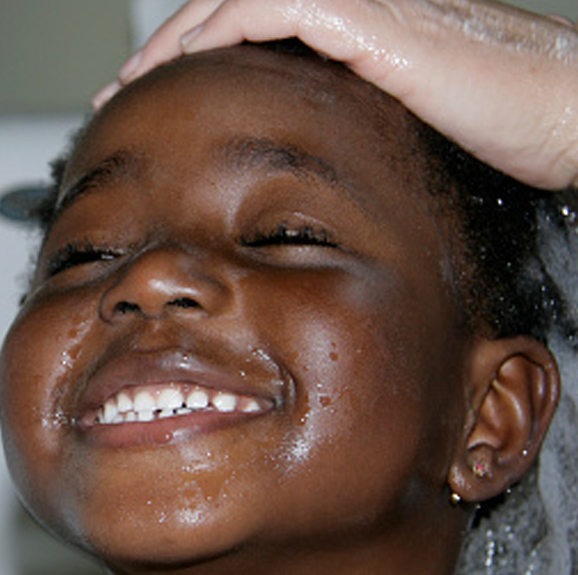HOW DO I DETECT HEAD LICE IN MY CHILD’S HAIR?
We know life is busy and sometimes it feels like there aren’t enough hours in the day, but it’s really important to set some time aside to check your child’s hair on a regular basis. Some children may have all of the symptoms below, others may have one or two – the only effective way to detect lice is to nit comb the hair regularly:
- Itching – not everyone itches when they have head lice, but it can be a sign that they’ve moved in
- Small specs of black on the hairline – these are nits that grip tightly to the base of the hair, where the scalp is warmest
- Red bumps or marks on the scalp – lice can sometimes leave bites on the head, although this is fairly rare
- White specs in the hair – sometimes mistaken for dandruff, these are actually discarded eggshells
- Increased irritability – some children may show signs of irritability or disturbed sleep patterns
IS AN ITCHY HEAD THE MAIN SYMPTOM OF HAVING HEAD LICE?
No, not necessarily. Itching only appears in 30% of cases, so you can have head lice and not have an itchy scalp. Contrary to what you may have heard in the past, an itchy head is not a result of the lice biting, but instead an allergic reaction to secretions made by the lice. Share this fact with your child to induce immediate groans of disgust!

WHAT IS ‘WET COMBING’?
Wet combing’ is the technique most commonly used by parents to detect lice. It’s the most effective method of lice removal if you don’t want to regularly use harsh chemicals on your child’s hair.
First, wash the hair thoroughly so it’s completely saturated, then cover it with a generous amount of conditioner. If your child has really thick hair, you’ll need mammoth amounts and you’ll also need to brush the hair first so it’s completely free of tangles. Then let battle commence – this is where it gets messy.
For ease, section the hair if you can and run the comb down the shaft from root to tip in each section; it’s best to repeat this process a couple of times if you can get away with it. Try to be as gentle as you can as nit combs can pull the hair, and always make sure the hair is well lubricated. The aim is to have a calm, happy child at the end of the process, rather than a screaming fiend who refuses to ever let you go near their hair again. If you can nail this with minimal tears, you deserve to be crowned parent of the year.
WHAT AM I LOOKING FOR?
If your child has head lice you’ll notice two things when combing their hair. Firstly, you’ll see tiny black eggs in the teeth of the comb. Secondly, you’ll see lice of all shapes and sizes. Don’t be alarmed, they won’t bite, jump or crawl on you. If time is on your side, it’s best to clean the comb before going in for the next section of hair.

WHAT TYPE OF COMB SHOULD I BUY?
We think it’s always worth investing in a good quality comb; if you do this it should last you a lifetime. Well, at least until the nits have given up and departed for good.
Some people swear by metal combs, others prefer plastic ones – it’s all down to personal choice and what works for you and your little one. However, research has shown that a fine-toothed plastic detection comb is better for finding live head lice as the teeth are rigid enough to catch the smallest of lice. Metal combs tend to be more effective at removing the nits and hatched white egg cases that are often stuck to the hair shaft.
Whatever you opt for, the comb should have teeth spaced less than 0.3mm, but at least 0.2mm apart. Always clean your comb after every use.
WHAT ARE HEAD LICE?
When nasty critters set up camp in your child’s hair it can be a frustrating process trying to eliminate them. But fear not, we can help you with your challenge. So what steps can you take to stop them invading hair in the first place and what should you do if you receive that dreaded head lice letter from school?

WHAT IS A HEAD LOUSE?
Anyone with a phobia of creepy crawlies, look away now. The common head louse, otherwise known as Pediculus humanus capitis, is an obligate ectoparasite that lives on the human scalp. In other words, it’s a tiny insect – usually between 2.5 to 3mm long – that needs a host to survive and lives on the surface of that host, i.e. your child!
It’s a known fact that lice love children’s hair: school, playgroups and large groups of children are the perfect breeding grounds for these pesky pests. Once safely ensconced in the hair of your unsuspecting child, they survive by biting into the scalp and feeding off human blood. Thankfully, unlike body lice, they do not carry disease. Contrary to what you may have heard, they can’t fly or jump but can move of speeds of up to 23cm in a minute. Now that’s fast.
WHY DO HEAD LICE CAUSE SUCH AN ITCHY SCALP?
Believe it or not, it’s not the biting that causes your child to itch. The annoying itching is actually an allergic reaction to secretions from the lice, which is enough to make your skin crawl, let alone your head itch. Some people don’t itch when they’ve got an infestation, so you can’t take itching as a sign of unwelcome visitors. The only way to remedy the problem and keep your child happy and nit-free is to check little heads regularly and introduce weekly nit combing sessions. It sounds like a drag, but we promise you’ll thank us for it in the end.

ARE HEAD LICE AND NITS THE SAME THING?
No they’re not. Nits are the tiny blackish or brown eggs that cling to the root of the hair and can be a real pain to remove, leading to unpleasant scenes at sunset. Once the lice have hatched they leave behind white eggshells that look similar to dandruff. Lice are the living, crawling critters in your child’s hair that can only be defeated with death defying displays of skill, tears and tantrums (yours, not theirs!).

WHAT IS THE LIFE CYCLE OF A LOUSE?
Sadly for us parents, lice are clever little critters. They are pretty much undetectable to the human eye (unless you look really closely and have eyes like an eagle), can survive a hair wash by clinging to a strand of hair and during its 30-day life cycle, a female lice can lay five to 10 eggs a day. This means it’s vital to be consistent with detection and treatment.
In fact, like most females, the female louse is a deft operator. After she has mated once, she never has to mate again. She simply keeps spare sperm in a special part of her body, using it as she goes, laying eggs daily for the next 30 days. Now that’s what we call multi-tasking.
To eliminate lice once and for all and ensure a tear-free, tantrum-free bath time, you need to understand the life cycle, which goes something like this:
- Head lice live for around 30 days
- Eggs hatch after seven to 10 days
- It takes 10-14 days for lice to become adults
- Once fully grown adults, lice will mate with each other
- One to two days after mating the female will lay her first egg
- The female can lay eight to 10 eggs per day
- The average infestation is around 20 lice, but left untreated numbers can quickly escalate into the hundreds
HOW PREVALENT ARE HEAD LICE?
Remember when every school had a nit nurse and childhood was much simpler? Sadly this isn’t a luxury most schools have any more, so it’s down to us parents to eradicate the head lice and show them who’s boss. We know you can do it!
Head lice have been around for as long as humans have existed. They are definitely not a sign of poor hygiene in children or dirty hair, just an incredibly common part of childhood. In a recent survey conducted by Vosene, over 63% of parents we spoke to with 4-11-year-olds said their child had suffered from head lice at some point in their life. So it’s down to us to get them under control and free our children’s hair of nasty nits – let the battle commence.

Article written using the following sources:
Healthy children.org, Head Lice: What Parents Need to Know, American Academy of Pediatrics, October 2020
British Association of Dermatologists, Head Lice, October 2020
AFP, Wet combing for the eradication of head lice, The Royal Australian College of General Practitioners, March 2013
NHS, Head lice and nits, March 2021
Very Well Health, The 8 Best Lice Combs of 2021, Danielle Zoellner, October 2021
CDC, Head Lice FAQ’s, Global Health, Division of Parasitic Diseases and Malaria, September 2020
